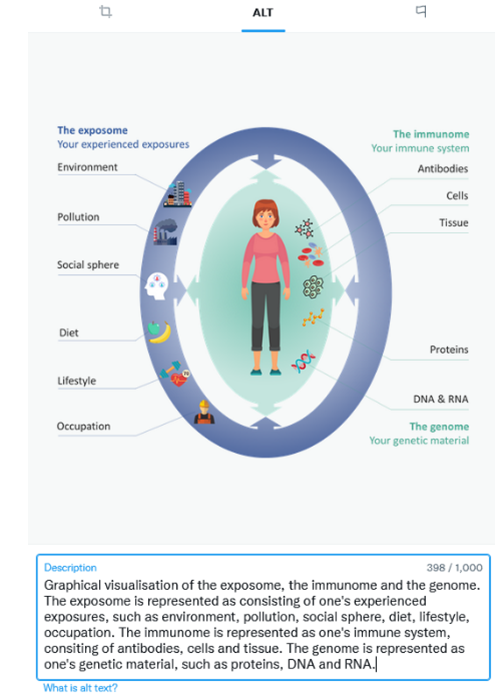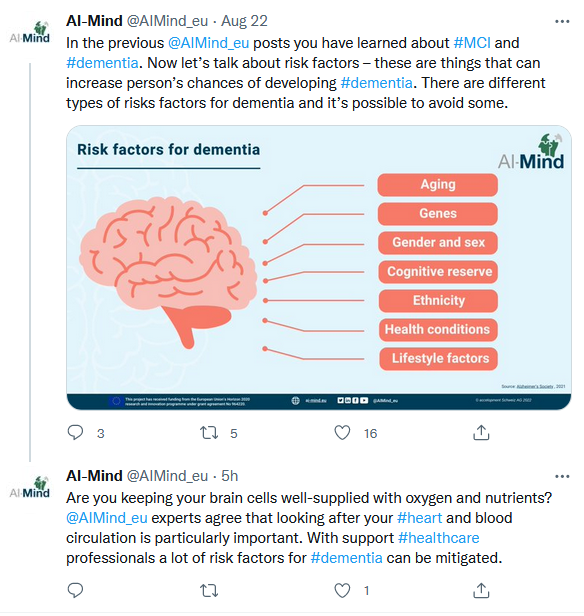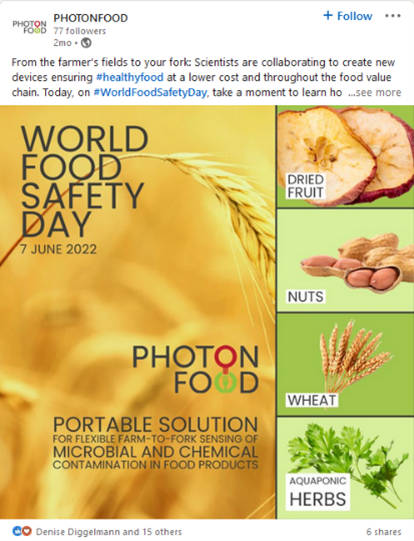Social media for EU projects – sharing content at the forefront of research
26th August 2022 at 8:00 am
EU-funded projects have the advantageous position of being at the forefront of research, where they first-handedly bring to life the latest scientific developments, innovations and technologies resulting in new concepts, methodologies, products, even therapies that benefit society. While this comes along with a good deal of responsibility, and the need to ensure an ethically and morally correct communication approach, EU-funded projects have the opportunity to share informative and educational content with a broad range of stakeholders, through social media. While in a previous blog post we covered the key steps in getting started with social media for EU projects, today we explore what content to share to combine both trustworthy and engaging information.
Seize the opportunities to share informative content
Sharing informative content is one of the best ways to keep a community of followers and connections engaged. EU-funded projects have a lot to share, but it is a collaborative effort that should involve all partners and will require some effort. A good way to start is by introducing the project and its team, explaining the project’s key objectives and highlighting each partner’s contribution. This can be done by breaking down complex concepts into small bites of easy-to-grasp information and key facts delivered over a series of multiple posts. Involving the project partners in the creative process, especially by including images or short videos from their team members, will add that human perspective that is naturally of interest to most users, while also helping create a stronger sense of community and collaboration within the project itself. Generally, adding the human side to social media posts, with profile and team pictures or recorded audio-visual content, helps with giving the project an identity and building trustworthiness while also offering the team members themselves an opportunity to strengthen their public profile. The latter can be particularly helpful for early-career researchers, especially on career-oriented platforms, such as LinkedIn.
Another way of sharing informative content can be by introducing the community of followers to the key terminology and research questions addressed by the project through a “word/question of the day/week/month” series. This approach not only establishes continuity in the posts, but also allows the audience to gather a better understanding of the project at a digestible speed. As a society, we are brought and live by narrations. Storytelling lies in our nature, in how information and knowledge are shared. Hence, using storytelling in running an educational campaign to raise awareness on a specific topic ideally corresponds to the needs of all project stakeholders and can be done in the first months of the project lifecycle.
As the project progresses and the first shareable results become available, social media channels are a great platform to further disseminate these. Sharing new publications through social media contributes to the project’s dissemination but can also be a moment to spotlight a certain team or researcher, a specific methodology, or a research question, through accompanying posts. Setting up a template for announcing new publications can be one way of making these posts easily recognizable among followers. Announcing the key outcomes of the research through infographics, a short video, or a thread of tweets are just some examples of how project results can be made more accessible by a diverse audience.
Events, conferences and workshops all represent opportunities to share informative content. Posting about events in advance will be crucial to promote participation but is also a time that can be used to provide background on the topics that the project will be covering at the event, be it a self-organized workshop or an international conference to which the project will contribute to with presentations by its researchers. For early-career researchers who might not yet be as well-networked in the scientific community as their more senior colleagues, informing about their participation to a conference in advance and sharing some teasers of what will be presented can be a good way to help build an interest among possible conference attendees in advance and trigger networking opportunities. Sharing key outcomes from the event as it takes place and also afterwards, as a follow-up, is an ideal way to inform on the project’s progress and highlight its latest results, making use of the momentum that is often created especially around well-established, international events and conferences.
The list of opportunities continues, including consortium events, training sessions, secondment visits in the case of MSCA projects, and many other moments throughout the course of the project that can offer opportunities to interact with stakeholders by sharing updates through social media and building upon these in creative ways, asking questions, initiating polls, creating a thematic series, etc. The next step, after having identified an opportunity to share informative, project-related content, is to do so in an effective way. This is where the social media post itself comes to life.
Write for clarity
The type and length of text included in social media posts will vary depending on the platform used, as each has different character limitations and diverse user demographics. For example, while Twitter has a character limit for text of 280 characters, LinkedIn and Facebook are perfect for long written posts, articles, guides and blogs, especially for texts that are 1’500 words or longer. While of course the language should also be adapted depending on the targeted audience, it is generally good practice to be concise, while maintaining clarity, and create messages that are easy to share. Especially for platforms like Twitter, Facebook and LinkedIn, starting a post with a question or including a poll helps catch the attention and interest the audience in reading further. Links to additional information and a call to action are good elements to include to leave the audience with something to think about and do, maintaining the interest also at the end of the post. The use of acronyms, while very common within the context of EU projects, should be avoided when these are not commonly known. On the other hand, including hashtags of relevance to the project and specific ones defined for the project itself, will help make the posts more easily findable by those users who have an interest in the topic.
Care for visuals and accessibility
A well-prepared text will benefit from the inclusion of visuals. Published statistics indicate that posts with images or visuals have 98% higher comment rates on LinkedIn, are three times more likely to get engagement on Twitter and gather more likes and comments on Facebook. This comes as little surprise, considering that a substantial part of the population are visual learners. Maintaining a consistent visual identity for the project across social media platforms will make its posts easily recognisable. Bearing this in mind alongside the combined use of different types of visuals will enable reaching diverse audiences. While in certain cases the same visual can be easily adapted to the format requirements of different social media channels, for example with the use of Canva, Adobe Express or other similar tools, each type of visual will be more suitable for one or the other social media platforms. For example, infographics or visuals that also include text can be used on Twitter to get more information across overcoming the 280 characters limit for the text in the tweet itself. Twitter also supports short videos, which, as confirmed by the platform’s statistics are an effective way of engaging with followers, as tweets with video attract ten times more engagements than those without. Real-time posting of photos and videos, for example from the laboratory, a conference or an event is well suited to the faster-moving social media platforms, like Twitter, Instagram and Facebook. Longer project introductory videos, explainer videos, interviews, recordings of webinars and events are best shared via YouTube but highlights of these or links to them can also be shared via other social media channels, reaching a broader audience. LinkedIn supports the inclusion of PDFs and slide sharing, which can be used to increase the ease of accessibility to conference presentations and project newsletters.

Over one billion people, or 15% of the world’s population, experience some form of disability, ranging from auditory, cognitive, neurological, physical, speech, or visual impairment. Non-inclusive content can discourage people to follow the project news and engage in any interaction.
We already explored this aspect in the context of website accessibility, but it is also of key importance for the use of social media and especially the visuals shared through such channels. While adding subtitles to audio-visual material and choosing accessible colour combinations for visuals are well-known practices and since long supported by video editing and design platforms, the inclusion of Alt text, or alternative text, to depict visuals has only recently become more widely supported. Several of the most commonly used social media platforms now also feature the option to include Alt text. This consists in a simple, written description of what is represented by the visual and a transcription of any text contained within it. Adding Alt text to visuals shared on social media makes them accessible also to users with vision impairment who might use screen readers to access the Web. Despite the project’s targeted audience, making use of Alt text and increasing the accessibility of content through the use of mixed media is considered as best practice and can at the same time increase the project’s impact.
Benefit from our experience at accelopment
With a passion for making science more accessible to all, at accelopment we have been supporting more than thirty Horizon 2020 projects over the past years and we are already involved in eleven Horizon Europe projects as partners leading the communication, dissemination and exploitation activities. Our communications team values the importance of knowledge sharing and building on previous experiences, which is why in the coming months we will publish a series of blog posts offering guidance and tips to implement in the communication, dissemination, and exploitation of your own research or innovation. Stay tuned and contact us to find out how we can support your project’s communication activities.

Joanna Plesniak
Project Manager Communications



